A Bibliometric Analysis and Review of Building Information Modelling for Post-Disaster Reconstruction
Abstract
:1. Introduction
2. Methodology
3. Results and Interpretation of Articles
3.1. Analysis of Published Journals
3.2. Analysis of Co-Authorship
3.3. Analysis of Co-Occurring Keywords
3.4. Analysis of Article Citations
3.5. Analysis of Countries
4. Discussion
4.1. Post-Disaster Reconstruction
4.2. Building Information Modelling (BIM)
4.3. Disaster Management and Building Information Modelling
5. Conceptual Framework
6. Conclusions
Author Contributions
Funding
Institutional Review Board Statement
Informed Consent Statement
Data Availability Statement
Acknowledgments
Conflicts of Interest
References
- Gunes, A.E.; Kovel, J.P. Using GIS in Emergency Management Operations. J. Urban Plan. Dev. 2000, 126, 136–149. [Google Scholar] [CrossRef]
- Barakat, S. Housing Reconstruction after Conflict and Disaster. Humanit. Policy Group Netw. Pap. 2003, 43, 1–40. [Google Scholar]
- Bilau, A.; Witt, E.; Lill, I. Practice Framework for the Management of Post-Disaster Housing Reconstruction Programmes. Sustainability 2018, 10, 3929. [Google Scholar] [CrossRef] [Green Version]
- Anilkumar, S.; Banerji, H. An Inquiry into Success Factors for Post-Disaster Housing Reconstruction Projects: A Case of Kerala, South India. Int. J. Disaster Risk Sci. 2021, 12, 24–39. [Google Scholar] [CrossRef]
- Ismail, D.; Majid, T.; Roosli, R. Analysis of Variance of the Effects of a Project’s Location on Key Issues and Challenges in Post-Disaster Reconstruction Projects. Economies 2017, 5, 46. [Google Scholar] [CrossRef] [Green Version]
- Bilau, A.; Witt, E.; Lill, I. Analysis of Measures for Managing Issues in Post-Disaster Housing Reconstruction. Buildings 2017, 7, 29. [Google Scholar] [CrossRef] [Green Version]
- Ismail, D.; Majid, T.A.; Roosli, R.; Samah, N.A. Project Management Success for Post-Disaster Reconstruction Projects: International NGOs Perspectives. Procedia Econ. Financ. 2014, 18, 120–127. [Google Scholar] [CrossRef]
- Dias, N.T.; Keraminiyage, K.; DeSilva, K.K. Long-Term Satisfaction of Post Disaster Resettled Communities. Disaster Prev. Manag. Int. J. 2016, 25, 581–594. [Google Scholar] [CrossRef] [Green Version]
- Enshassi, A.; Chatat, T.; von Meding, J.; Forino, G. Factors Influencing Post-Disaster Reconstruction Project Management for Housing Provision in the Gaza Strip, Occupied Palestinian Territories. Int. J. Disaster Risk Sci. 2017, 8, 402–414. [Google Scholar] [CrossRef] [Green Version]
- Alaloul, W.S.; Alfaseeh, A.S.; Tayeh, B.A.; Zawawi, N.A.W.A.; Liew, M.S. Reconstruction of Residential Buildings Post-Disaster: A Comparison of Influencing Factors. AIP Conf. Proc. 2019, 2157, 020035. [Google Scholar] [CrossRef]
- Charles, S.H.; Chang-Richards, A.; Yiu, T.W. What Do Post-Disaster Reconstruction Project Success Indicators Look like? End-User’s Perspectives. Int. J. Disaster Resil. Built Environ. 2021. [Google Scholar] [CrossRef]
- Islam, M.Z.; Kolade, O.; Kibreab, G. Post-Disaster Housing Reconstruction: The Impact of Resourcing in Post-Cyclones Sidr and Aila in Bangladesh. J. Int. Dev. 2018, 30, 934–960. [Google Scholar] [CrossRef]
- Bilau, A.; Witt, E. An Analysis of Issues for the Management of Post-Disaster Housing Reconstruction. Int. J. Strateg. Prop. Manag. 2016, 20, 265–276. [Google Scholar] [CrossRef]
- Capell, T.; Ahmed, I. Improving Post-Disaster Housing Reconstruction Outcomes in the Global South: A Framework for Achieving Greater Beneficiary Satisfaction through Effective Community Consultation. Buildings 2021, 11, 145. [Google Scholar] [CrossRef]
- Sospeter, N.G.; Rwelamila, P.M.D.; Gimbi, J. Project Management Challenges for Post-Disaster Reconstruction Projects in Angola: A Public Sector Perspective. Int. J. Manag. Proj. Bus. 2020, 14, 767–787. [Google Scholar] [CrossRef]
- Aliakbarlou, S.; Wilkinson, S.; Costello, S.B.; Jang, H. Client Values within Post-Disaster Reconstruction Contracting Services. Disaster Prev. Manag. 2017, 26, 348–360. [Google Scholar] [CrossRef]
- Yaakob, M.; Ali, W.N.A.W.; Radzuan, K. Identifying Critical Success Factors (CSFs) of Implementing Building Information Modeling (BIM) in Malaysian Construction Industry. AIP Conf. Proc. 2016, 1761, 020105. [Google Scholar]
- Abdirad, H. Metric-Based BIM Implementation Assessment: A Review of Research and Practice. Archit. Eng. Des. Manag. 2017, 13, 52–78. [Google Scholar] [CrossRef]
- Abd Hamid, A.B.; Mohd Taib, M.Z.; Abdul Razak, A.H.N.; Embi, M.R. Building Information Modelling: Challenges and Barriers in Implement of BIM for Interior Design Industry in Malaysia. IOP Conf. Ser. Earth Environ. Sci. 2018, 140, 012002. [Google Scholar] [CrossRef]
- Howard, R.; Restrepo, L.; Chang, C.-Y. Addressing Individual Perceptions: An Application of the Unified Theory of Acceptance and Use of Technology to Building Information Modelling. Int. J. Proj. Manag. 2017, 35, 107–120. [Google Scholar] [CrossRef]
- Kim, S.; Park, C.H.; Chin, S. Assessment of BIM Acceptance Degree of Korean AEC Participants. KSCE J. Civ. Eng. 2016, 20, 1163–1177. [Google Scholar] [CrossRef]
- Al-Ashmori, Y.Y.; Othman, I.; Rahmawati, Y.; Amran, Y.H.M.; Sabah, S.H.A.; Rafindadi, A.D.; Mikić, M. BIM Benefits and Its Influence on the BIM Implementation in Malaysia. Ain Shams Eng. J. 2020, 11, 1013–1019. [Google Scholar] [CrossRef]
- Georgiadou, M.C. An Overview of Benefits and Challenges of Building Information Modelling (BIM) Adoption in UK Residential Projects. Constr. Innov. 2019, 19, 298–320. [Google Scholar] [CrossRef]
- Wong, J.; Wang, X.; Li, H.; Chan, G. A Review of Cloud-Based BIM Technology in the Construction Sector. J. Inf. Technol. Constr. 2014, 19, 281–291. [Google Scholar]
- Shehzad, H.M.F.; Ibrahim, R.B.; Yusof, A.F.; Khaidzir, K.A.M. Building Information Modeling: Factors Affecting the Adoption in the AEC Industry. In Proceedings of the 2019 6th International Conference on Research and Innovation in Information Systems (ICRIIS), Johor Bahru, Malaysia, 2–3 December 2019; pp. 1–6. [Google Scholar]
- Haruna, A.; Shafiq, N.; Montasir, O.A. Building Information Modelling Application for Developing Sustainable Building (Multi Criteria Decision Making Approach). Ain Shams Eng. J. 2021, 12, 293–302. [Google Scholar] [CrossRef]
- Chan, D.W.M.; Olawumi, T.O.; Ho, A.M.L. Perceived Benefits of and Barriers to Building Information Modelling (BIM) Implementation in Construction: The Case of Hong Kong. J. Build. Eng. 2019, 25, 100764. [Google Scholar] [CrossRef]
- Gamil, Y.; Rahman, I.A.R. Awareness and Challenges of Building Information Modelling (BIM) Implementation in the Yemen Construction Industry. J. Eng. Des. Technol. 2019, 17, 1077–1084. [Google Scholar] [CrossRef]
- Saka; Chan A Scientometric Review and Metasynthesis of Building Information Modelling (BIM) Research in Africa. Buildings 2019, 9, 85. [CrossRef] [Green Version]
- Gan, L.; Wang, Y.; Lin, Z.; Lev, B. A Loss-Recovery Evaluation Tool for Debris Flow. Int. J. Disaster Risk Reduct. 2019, 37, 101165. [Google Scholar] [CrossRef]
- Dakhil, A.; Alshawi, M. Client’s Role in Building Disaster Management through Building Information Modelling. Procedia Econ. Financ. 2014, 18, 47–54. [Google Scholar] [CrossRef] [Green Version]
- Nawari, N.O.; Ravindran, S. Blockchain and Building Information Modeling (BIM): Review and Applications in Post-Disaster Recovery. Buildings 2019, 9, 149. [Google Scholar] [CrossRef] [Green Version]
- Messaoudi, M.; Nawari, N.O. BIM-Based Virtual Permitting Framework (VPF) for Post-Disaster Recovery and Rebuilding in the State of Florida. Int. J. Disaster Risk Reduct. 2020, 42, 101349. [Google Scholar] [CrossRef]
- Sepasgozar, S.M.E.; Hui, F.K.P.; Shirowzhan, S.; Foroozanfar, M.; Yang, L.; Aye, L. Lean Practices Using Building Information Modeling (BIM) and Digital Twinning for Sustainable Construction. Sustainability 2020, 13, 161. [Google Scholar] [CrossRef]
- Adegoriola, M.I.; Lai, J.H.K.; Chan, E.H.; Amos, D. Heritage Building Maintenance Management (HBMM): A Bibliometric-Qualitative Analysis of Literature. J. Build. Eng. 2021, 42, 102416. [Google Scholar] [CrossRef]
- Wu, Z.; Yang, K.; Lai, X.; Antwi-Afari, M.F. A Scientometric Review of System Dynamics Applications in Construction Management Research. Sustainability 2020, 12, 7474. [Google Scholar] [CrossRef]
- Qureshi, M.I.; Khan, N.; Qayyum, S.; Malik, S.; Hishan, S.S.; Ramayah, T. Classifications of Sustainable Manufacturing Practices in ASEAN Region: A Systematic Review and Bibliometric Analysis of the Past Decade of Research. Sustainability 2020, 12, 8950. [Google Scholar] [CrossRef]
- Liberati, A.; Altman, D.G.; Tetzlaff, J.; Mulrow, C.; Gøtzsche, P.C.; Ioannidis, J.P.A.; Clarke, M.; Devereaux, P.J.; Kleijnen, J.; Moher, D. The PRISMA Statement for Reporting Systematic Reviews and Meta-Analyses of Studies That Evaluate Health Care Interventions: Explanation and Elaboration. J. Clin. Epidemiol. 2009, 62, e1–e34. [Google Scholar] [CrossRef] [PubMed] [Green Version]
- Zhao, X.; Zuo, J.; Wu, G.; Huang, C. A Bibliometric Review of Green Building Research 2000–2016. Archit. Sci. Rev. 2019, 62, 74–88. [Google Scholar] [CrossRef]
- Aghaei Chadegani, A.; Salehi, H.; Yunus, M.; Farhadi, H.; Fooladi, M.; Farhadi, M.; Ale Ebrahim, N. A Comparison between Two Main Academic Literature Collections: Web of Science and Scopus Databases. Asian Soc. Sci. 2013, 9, 18–26. [Google Scholar] [CrossRef] [Green Version]
- van Eck, N.J.; Waltman, L. Software Survey: VOSviewer, a Computer Program for Bibliometric Mapping. Scientometrics 2010, 84, 523–538. [Google Scholar] [CrossRef] [PubMed] [Green Version]
- Wu, Z.; Chen, C.; Cai, Y.; Lu, C.; Wang, H.; Yu, T. BIM-Based Visualization Research in the Construction Industry: A Network Analysis. Int. J. Environ. Res. Public Health 2019, 16, 3473. [Google Scholar] [CrossRef] [Green Version]
- Darko, A.; Chan, A.P.C.; Adabre, M.A.; Edwards, D.J.; Hosseini, M.R.; Ameyaw, E.E. Artificial Intelligence in the AEC Industry: Scientometric Analysis and Visualization of Research Activities. Autom. Constr. 2020, 112, 103081. [Google Scholar] [CrossRef]
- Ren, R.; Hu, W.; Dong, J.; Sun, B.; Chen, Y.; Chen, Z. A Systematic Literature Review of Green and Sustainable Logistics: Bibliometric Analysis, Research Trend and Knowledge Taxonomy. Int. J. Environ. Res. Public Health 2019, 17, 261. [Google Scholar] [CrossRef] [Green Version]
- Jin, R.; Gao, S.; Cheshmehzangi, A.; Aboagye-Nimo, E. A Holistic Review of Off-Site Construction Literature Published between 2008 and 2018. J. Clean. Prod. 2018, 202, 1202–1219. [Google Scholar] [CrossRef] [Green Version]
- Hosseini, M.R.; Martek, I.; Zavadskas, E.K.; Aibinu, A.A.; Arashpour, M.; Chileshe, N. Critical Evaluation of Off-Site Construction Research: A Scientometric Analysis. Autom. Constr. 2018, 87, 235–247. [Google Scholar] [CrossRef]
- Su, H.-N.; Lee, P.-C. Mapping Knowledge Structure by Keyword Co-Occurrence: A First Look at Journal Papers in Technology Foresight. Scientometrics 2010, 85, 65–79. [Google Scholar] [CrossRef]
- He, Q.; Wang, G.; Luo, L.; Shi, Q.; Xie, J.; Meng, X. Mapping the Managerial Areas of Building Information Modeling (BIM) Using Scientometric Analysis. Int. J. Proj. Manag. 2017, 35, 670–685. [Google Scholar] [CrossRef] [Green Version]
- van Eck, N.J.; Waltman, L. Visualizing Bibliometric Networks. In Measuring Scholarly Impact; Springer International Publishing: Cham, Germany, 2014; pp. 285–320. [Google Scholar]
- Biagini, C.; Capone, P.; Donato, V.; Facchini, N. Towards the BIM Implementation for Historical Building Restoration Sites. Autom. Constr. 2016, 71, 74–86. [Google Scholar] [CrossRef]
- Noor, S.; Shah, L.; Adil, M.; Gohar, N.; Saman, G.E.; Jamil, S.; Qayum, F. Modeling and Representation of Built Cultural Heritage Data Using Semantic Web Technologies and Building Information Model. Comput. Math. Organ. Theory 2019, 25, 247–270. [Google Scholar] [CrossRef]
- Nawari, N.O. BIM Data Exchange Standard for Hydro-Supported Structures. J. Archit. Eng. 2019, 25, 04019015. [Google Scholar] [CrossRef]
- Xu, Z.; Zhang, H.; Lu, X.; Xu, Y.; Zhang, Z.; Li, Y. A Prediction Method of Building Seismic Loss Based on BIM and FEMA P-58. Autom. Constr. 2019, 102, 245–257. [Google Scholar] [CrossRef]
- Brumana, R.; Della Torre, S.; Previtali, M.; Barazzetti, L.; Cantini, L.; Oreni, D.; Banfi, F. Generative HBIM Modelling to Embody Complexity (LOD, LOG, LOA, LOI): Surveying, Preservation, Site Intervention—The Basilica Di Collemaggio (L’Aquila). Appl. Geomatics 2018, 10, 545–567. [Google Scholar] [CrossRef]
- Sani, M.J.; Abdul Rahman, A. GIS and BIM Integration at Data Level: A Review. ISPRS Int. Arch. Photogramm. Remote Sens. Spat. Inf. Sci. 2018, 42, 299–306. [Google Scholar] [CrossRef] [Green Version]
- Brumana, R.; Della Torre, S.; Oreni, D.; Cantini, L.; Previtali, M.; Barazzetti, L.; Banfi, F. SCAN to HBIM-Post Earthquake Preservation: Informative Model as Sentinel at the Crossroads of Present, Past, and Future. In Lecture Notes in Computer Science (Including Subseries Lecture Notes in Artificial Intelligence and Lecture Notes in Bioinformatics); Springer International Publishing: Cham, Germany, 2018; Volume 11196 LNCS, pp. 39–51. ISBN 9783030017613. [Google Scholar]
- Brumana, R.; Della Torre, S.; Oreni, D.; Previtali, M.; Cantini, L.; Barazzetti, L.; Franchi, A.; Banfi, F. HBIM Challenge among the Paradigm of Complexity, Tools and Preservation: The Basilica Di Collemaggio 8 Years after the Earthquake (L’Aquila). ISPRS Int. Arch. Photogramm. Remote Sens. Spat. Inf. Sci. 2017, 42, 97–104. [Google Scholar] [CrossRef] [Green Version]
- Oreni, D.; Brumana, R.; Della Torre, S.; Banfi, F. Survey, HBIM and Conservation Plan of a Monumental Building Damaged by Earthquake. ISPRS Int. Arch. Photogramm. Remote Sens. Spat. Inf. Sci. 2017, XLII-5/W1, 337–342. [Google Scholar] [CrossRef] [Green Version]
- Ma, L.; Sacks, R.; Zeibak-Shini, R.; Aryal, A.; Filin, S. Preparation of Synthetic As-Damaged Models for Post-Earthquake BIM Reconstruction Research. J. Comput. Civ. Eng. 2016, 30, 04015032. [Google Scholar] [CrossRef] [Green Version]
- Ma, L.; Sacks, R.; Zeibak-Shini, R. Information Modeling of Earthquake-Damaged Reinforced Concrete Structures. Adv. Eng. Inform. 2015, 29, 396–407. [Google Scholar] [CrossRef]
- Carrie Sturts, D. Learning in Global Teams: BIM Planning and Coordination. Int. J. Autom. Smart Technol. 2015, 5, 119–135. [Google Scholar] [CrossRef] [Green Version]
- Lyons, M. Building Back Better: The Large-Scale Impact of Small-Scale Approaches to Reconstruction. World Dev. 2009, 37, 385–398. [Google Scholar] [CrossRef]
- Ika, L.A.; Diallo, A.; Thuillier, D. Critical Success Factors for World Bank Projects: An Empirical Investigation. Int. J. Proj. Manag. 2012, 30, 105–116. [Google Scholar] [CrossRef]
- Tagliacozzo, S. Government Agency Communication during Postdisaster Reconstruction: Insights from the Christchurch Earthquakes Recovery. Nat. Hazards Rev. 2018, 19, 04018001. [Google Scholar] [CrossRef]
- Rouhanizadeh, B.; Kermanshachi, S.; Dhamangaonkar, V.S. Identification and Categorization of Policy and Legal Barriers to Long-Term Timely Postdisaster Reconstruction. J. Leg. Aff. Disput. Resolut. Eng. Constr. 2019, 11, 1–10. [Google Scholar] [CrossRef]
- Chang, Y.; Wilkinson, S.; Potangaroa, R.; Seville, E. Identifying Factors Affecting Resource Availability for Post-disaster Reconstruction: A Case Study in China. Constr. Manag. Econ. 2011, 29, 37–48. [Google Scholar] [CrossRef]
- Sharma, K.; KC, A.; Subedi, M.; Pokharel, B. Post Disaster Reconstruction after 2015 Gorkha Earthquake: Challenges and Influencing Factors. J. Inst. Eng. 2018, 14, 52–63. [Google Scholar] [CrossRef]
- Sadiqi, Z.; Trigunarsyah, B.; Coffey, V. A Framework for Community Participation in Post-Disaster Housing Reconstruction Projects: A Case of Afghanistan. Int. J. Proj. Manag. 2017, 35, 900–912. [Google Scholar] [CrossRef]
- Shi, M.; Cao, Q.; Ran, B.; Wei, L. A Conceptual Framework Integrating “Building Back Better” and Post-Earthquake Needs for Recovery and Reconstruction. Sustainability 2021, 13, 5608. [Google Scholar] [CrossRef]
- Rouhanizadeh, B.; Kermanshachi, S.; Nipa, T.J. Exploratory Analysis of Barriers to Effective Post-Disaster Recovery. Int. J. Disaster Risk Reduct. 2020, 50, 101735. [Google Scholar] [CrossRef]
- Rouhanizadeh, B.; Kermanshachi, S. Barriers to an Effective Post-Recovery Process: A Comparative Analysis of the Public’s and Experts’ Perspectives. Int. J. Disaster Risk Reduct. 2021, 57, 102181. [Google Scholar] [CrossRef]
- Baarimah, A.O.; Alaloul, W.S.; Liew, M.S. Post-Disaster Reconstruction Projects in Developing Countries: An Overview. Lect. Notes Electr. Eng. 2022, 758. [Google Scholar] [CrossRef]
- Kermanshachi, S.; Rouhanizadeh, B. Feasibility Analysis of Post Disaster Reconstruction Alternatives Using Automated BIM-Based Construction Cost Estimation Tool. In Proceedings of the CSCE 6th International Disaster Mitigation Specialty Conference, Montreal: Canadian Society of Civil Engineering, Fredericton, NB, Canada, 13–16 June 2018; pp. 13–16. [Google Scholar]
- Ilhan, B.; Yaman, H. Meta-Analysis of Building Information Modeling Literature in Construction. Int. J. Eng. Innov. Technol. 2013, 3, 373–379. [Google Scholar]
- Montiel-Santiago, F.J.; Hermoso-Orzáez, M.J.; Terrados-Cepeda, J. Sustainability and Energy Efficiency: BIM 6D. Study of the BIM Methodology Applied to Hospital Buildings. Value of Interior Lighting and Daylight in Energy Simulation. Sustainability 2020, 12, 5731. [Google Scholar] [CrossRef]
- Bui, N.; Merschbrock, C.; Munkvold, B.E. A Review of Building Information Modelling for Construction in Developing Countries. Procedia Eng. 2016, 164, 487–494. [Google Scholar] [CrossRef]
- Kim, K.P.; Freda, R.; Nguyen, T.H.D. Building Information Modelling Feasibility Study for Building Surveying. Sustainability 2020, 12, 4791. [Google Scholar] [CrossRef]
- Obi, L.; Awuzie, B.; Obi, C.; Omotayo, T.S.; Oke, A.; Osobajo, O. BIM for Deconstruction: An Interpretive Structural Model of Factors Influencing Implementation. Buildings 2021, 11, 227. [Google Scholar] [CrossRef]
- Ghaffarianhoseini, A.; Tookey, J.; Ghaffarianhoseini, A.; Naismith, N.; Azhar, S.; Efimova, O.; Raahemifar, K. Building Information Modelling (BIM) Uptake: Clear Benefits, Understanding Its Implementation, Risks and Challenges. Renew. Sustain. Energy Rev. 2017, 75, 1046–1053. [Google Scholar] [CrossRef]
- Adekunle, S.A.; Ejohwomu, O.; Aigbavboa, C.O. Building Information Modelling Diffusion Research in Developing Countries: A User Meta-Model Approach. Buildings 2021, 11, 264. [Google Scholar] [CrossRef]
- The Business Value of BIM for Construction in Major Global Markets; SmartMarket Report; McGraw Hill Construction: New York, NY, USA, 2014; pp. 1–60.
- Doan, D.T.; GhaffarianHoseini, A.; Naismith, N.; Ghaffarianhoseini, A.; Zhang, T.; Tookey, J. Examining Critical Perspectives on Building Information Modelling (BIM) Adoption in New Zealand. Smart Sustain. Built Environ. 2020. [Google Scholar] [CrossRef]
- Hameed Memon, A.; Abdul Rahman, I.; Memon, I.; Iffah Aqilah Azman, N. BIM in Malaysian Construction Industry: Status, Advantages, Barriers and Strategies to Enhance the Implementation Level. Res. J. Appl. Sci. Eng. Technol. 2014, 8, 606–614. [Google Scholar] [CrossRef]
- Construction Industry Transformation Programme 2016–2020. CIDB Kuala Lumpur Malays. 2016, 184, 1–71.
- Drogemuller, R. BIM Support for Disaster Response. In Risk-Informed Disaster Management: Planning for Response, Recovery and Resilience; 2015; pp. 391–405. Available online: https://eprints.qut.edu.au/76145/1/E3.2.pdf (accessed on 5 December 2021).
- Kim, J.-E.; Hong, C.-H. A Study on the Application Service of 3D BIM-Based Disaster Integrated Information System Management for Effective Disaster Response. J. Korea Acad. Coop. Soc. 2018, 19, 143–150. [Google Scholar]
- Wang, B.; Li, H.; Rezgui, Y.; Bradley, A.; Ong, H.N. BIM Based Virtual Environment for Fire Emergency Evacuation. Sci. World J. 2014, 2014, 589016. [Google Scholar] [CrossRef] [PubMed]
- Boguslawski, P.; Mahdjoubi, L.; Zverovich, V.; Fadli, F.; Barki, H. BIM-GIS Modelling in Support of Emergency Response Applications. Build. Inf. Model. Des. Constr. Oper. 2015, 149, 381. [Google Scholar] [CrossRef] [Green Version]
- Lyu, H.-M.; Wang, G.-F.; Shen, J.; Lu, L.-H.; Wang, G.-Q. Analysis and GIS Mapping of Flooding Hazards on 10 May 2016, Guangzhou, China. Water 2016, 8, 447. [Google Scholar] [CrossRef] [Green Version]
- Sertyesilisik, B. Building Information Modeling as a Tool for Enhancing Disaster Resilience of the Construction Industry. Trans. VŠB Tech. Univ. Ostrava Saf. Eng. Ser. 2017, 12, 9–18. [Google Scholar] [CrossRef] [Green Version]
- Rad, M.A.H.; Jalaei, F.; Golpour, A.; Varzande, S.S.H.; Guest, G. BIM-Based Approach to Conduct Life Cycle Cost Analysis of Resilient Buildings at the Conceptual Stage. Autom. Constr. 2021, 123, 103480. [Google Scholar] [CrossRef]
- Ahuja, R.; Jain, M.; Sawhney, A.; Arif, M. Adoption of BIM by Architectural Firms in India: Technology–Organization–Environment Perspective. Archit. Eng. Des. Manag. 2016, 12, 311–330. [Google Scholar] [CrossRef] [Green Version]
- Chen, Y.; Yin, Y.; Browne, G.J.; Li, D. Adoption of Building Information Modeling in Chinese Construction Industry. Eng. Constr. Archit. Manag. 2019, 26, 1878–1898. [Google Scholar] [CrossRef]
- Ahmed, S.H.A.; Suliman, S.M.A. A Structure Equation Model of Indicators Driving BIM Adoption in the Bahraini Construction Industry. Constr. Innov. 2020, 20, 61–78. [Google Scholar] [CrossRef]
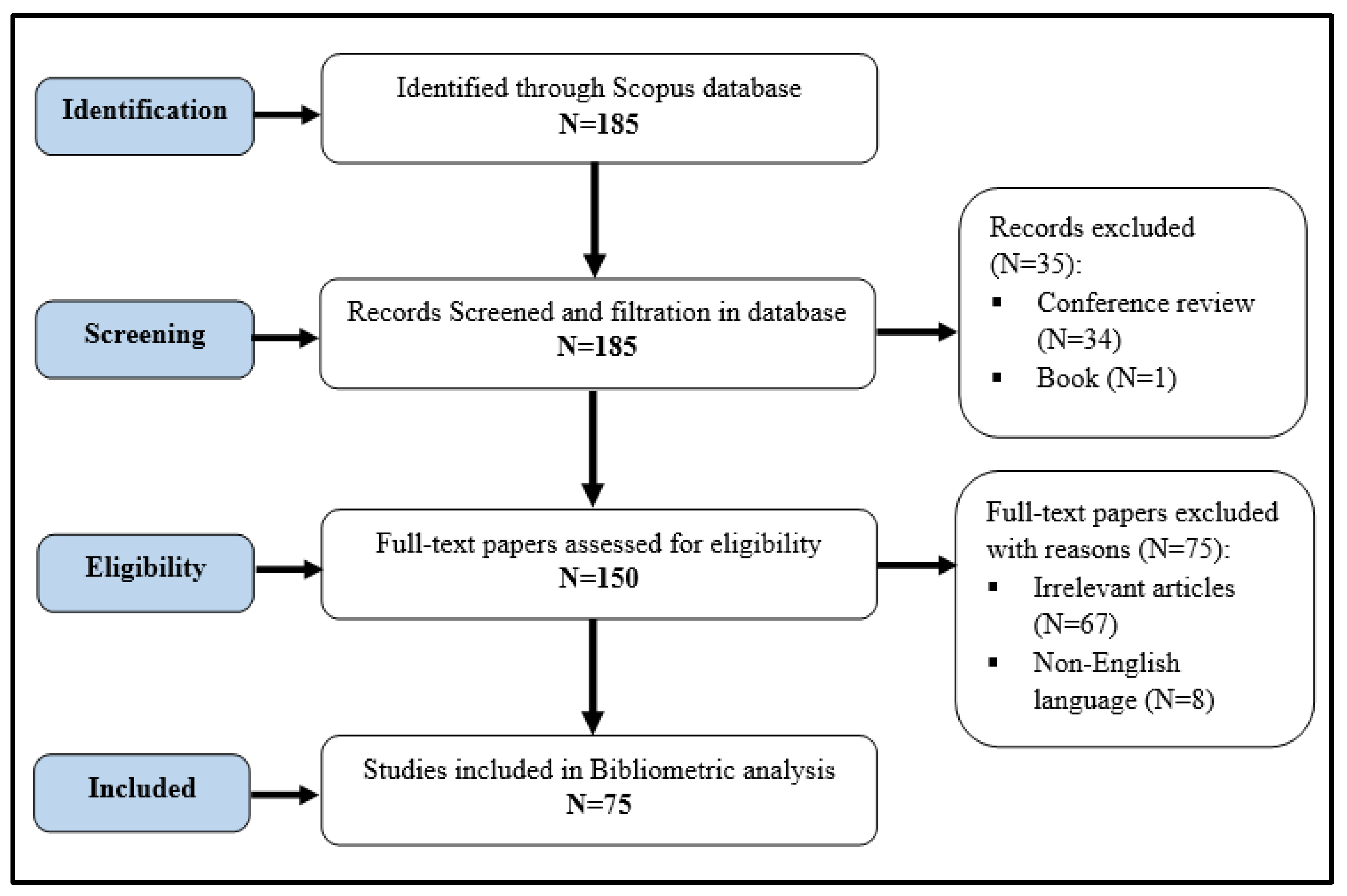
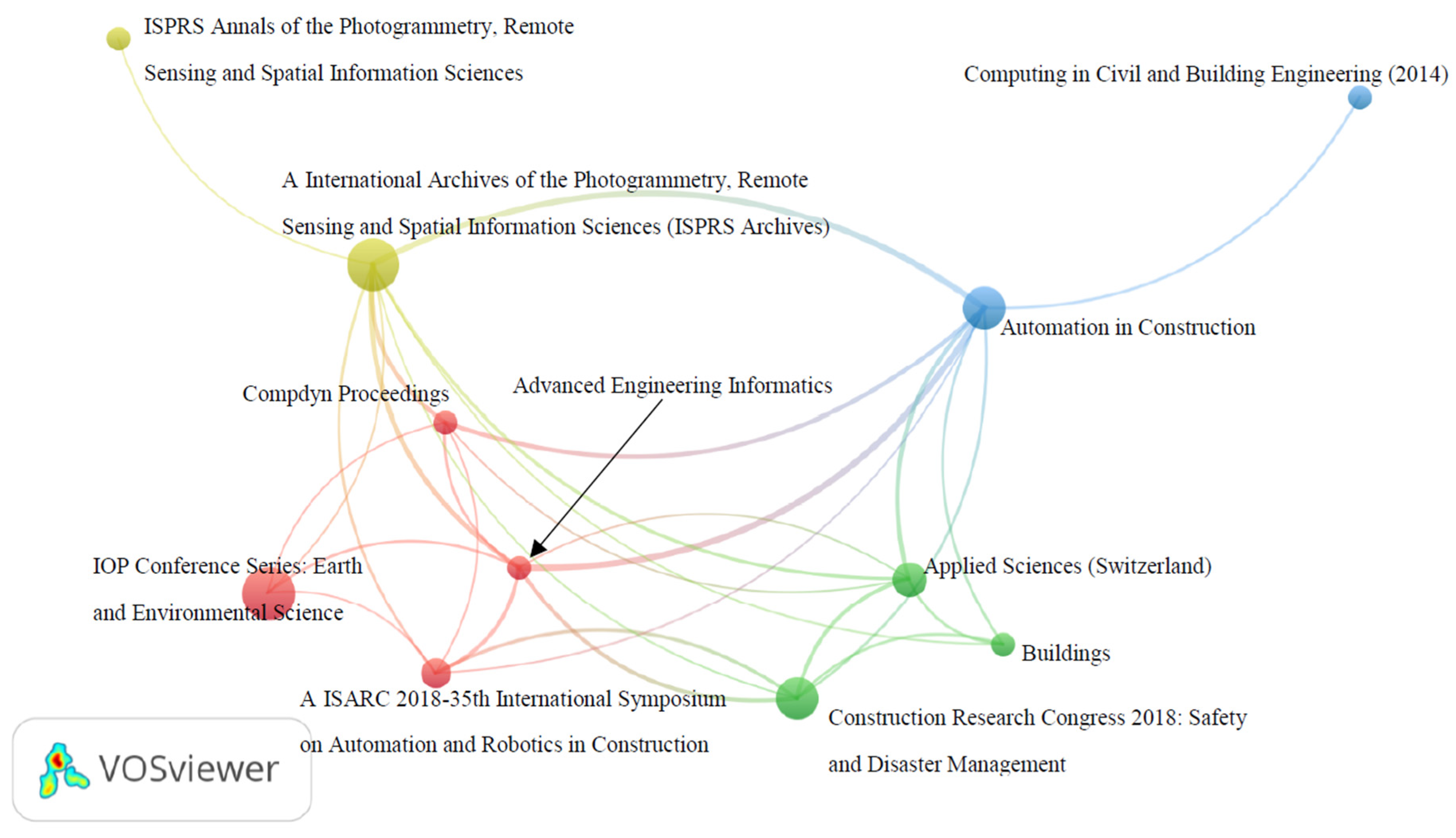

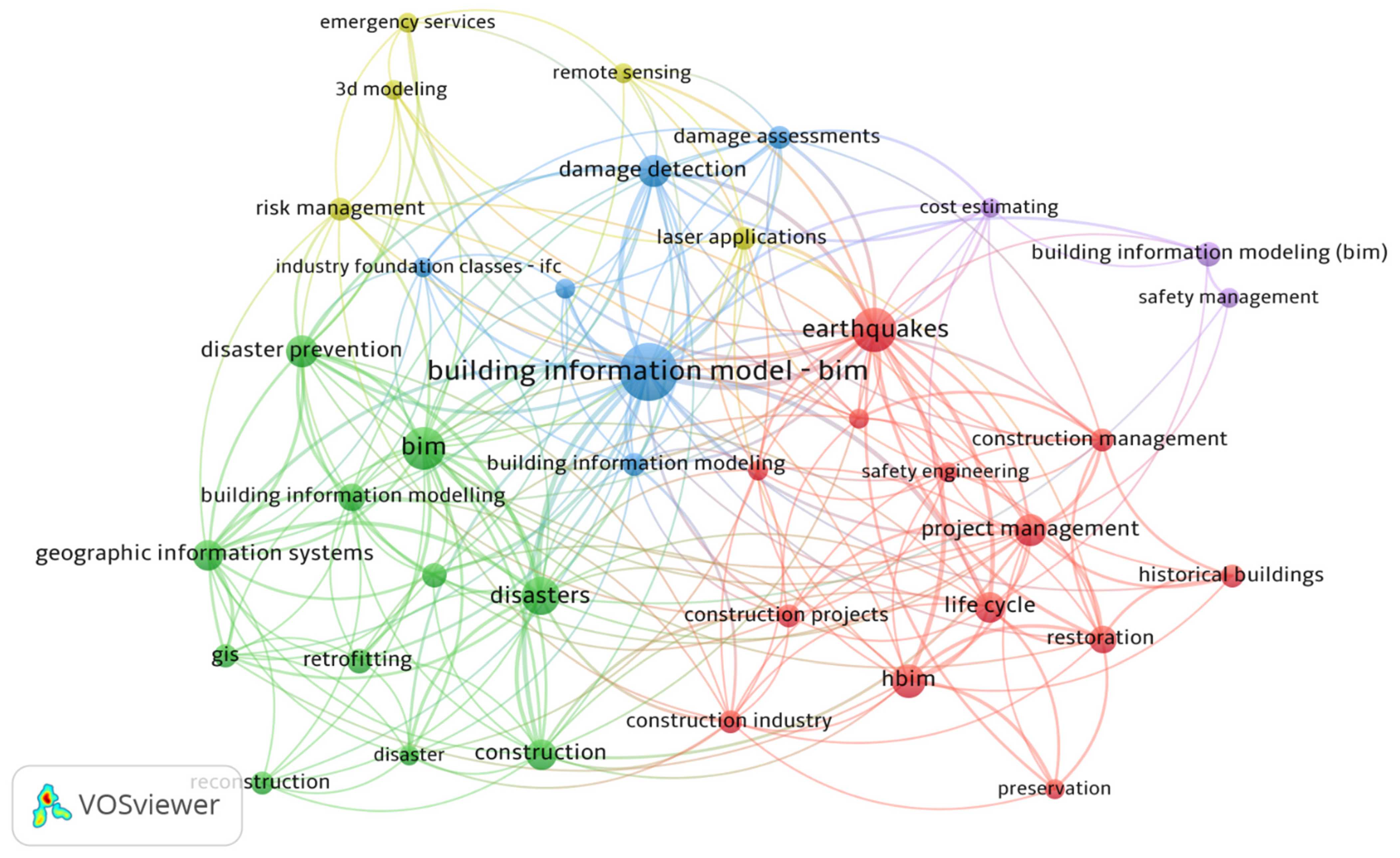
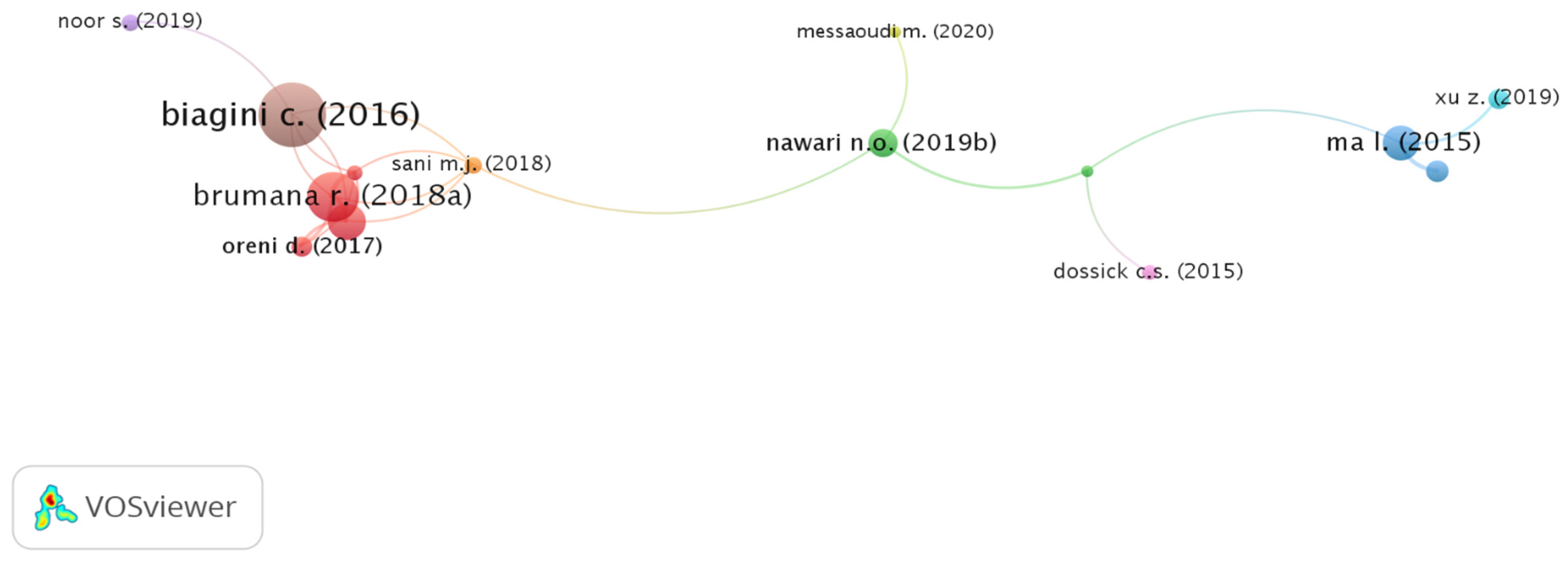

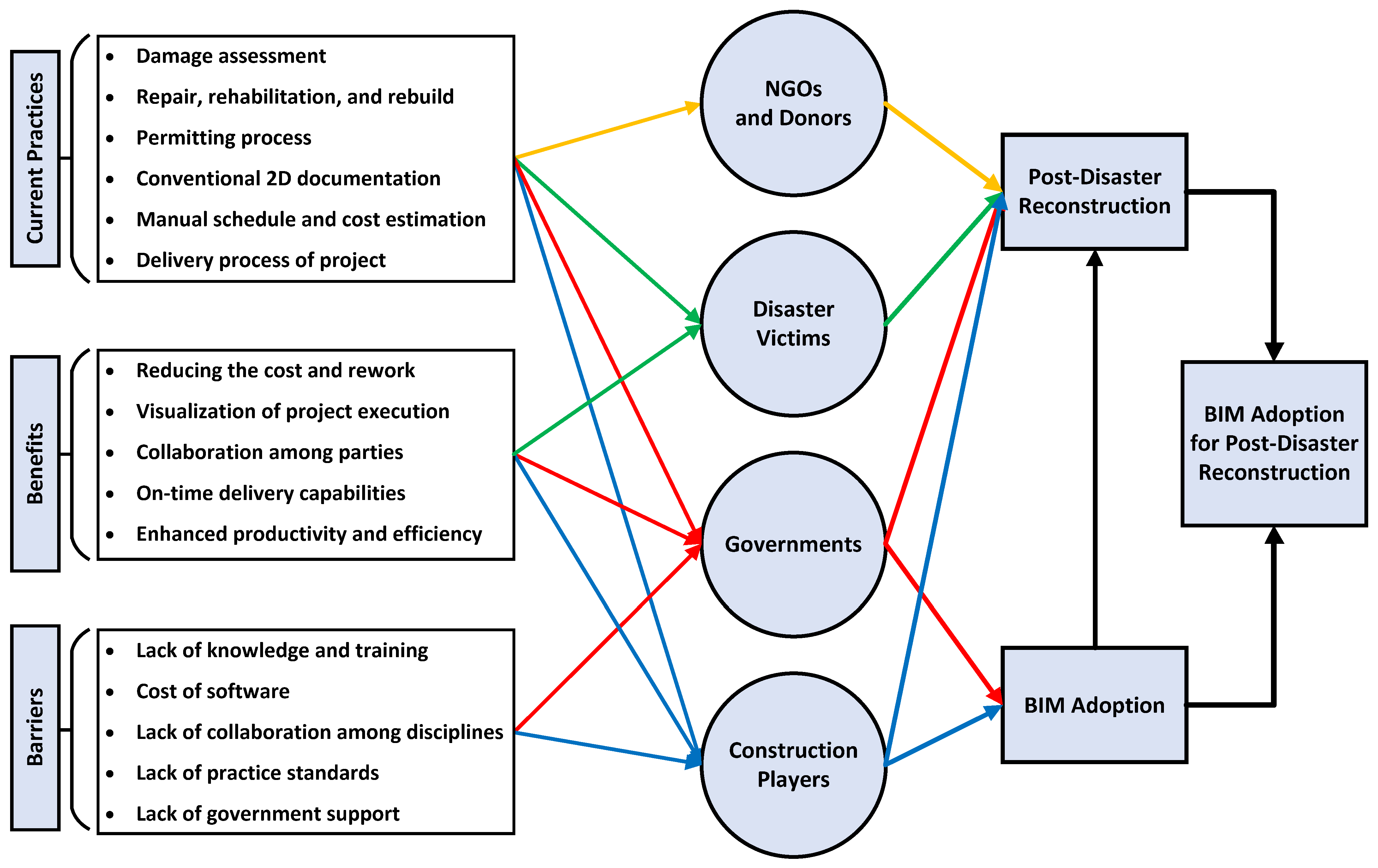
| No. | Source Journal | Total Link Strength | Documents | Total Citations | Avg. Citations | Avg. Norm. Citations |
|---|---|---|---|---|---|---|
| 1 | “Advanced Engineering Informatics” | 29 | 2 | 79 | 39.5 | 7.2 |
| 2 | “Applied Sciences (Switzerland)” | 16 | 4 | 12 | 3.0 | 2.2 |
| 3 | “Automation in Construction” | 36 | 6 | 111 | 18.5 | 2.3 |
| 4 | “Buildings” | 7 | 2 | 25 | 12.5 | 2.4 |
| 5 | “Compdyn Proceedings” | 15 | 2 | 1 | 0.5 | 0.1 |
| 6 | “Computing in Civil and Building Engineering (2014)” | 2 | 2 | 9 | 4.5 | 0.6 |
| 7 | “Construction Research Congress 2018: Safety and Disaster Management” | 16 | 6 | 19 | 3.2 | 0.6 |
| 8 | “International Archives of the Photogrammetry, Remote Sensing and Spatial Information Sciences (ISPRS Archives)” | 29 | 9 | 63 | 7.0 | 1.1 |
| 9 | “IOP Conference Series: Earth and Environmental Science” | 5 | 10 | 3 | 0.3 | 0.3 |
| 10 | “ISARC 2018—35th International Symposium on Automation and Robotics in Construction” | 12 | 3 | 4 | 1.3 | 0.3 |
| 11 | “ISPRS Annals of the Photogrammetry, Remote Sensing and Spatial Information Sciences” | 1 | 2 | 9 | 4.5 | 0.9 |
| Author | Total Link Strength | Documents | Total Citations | Avg. Pub. Year | Avg. Citations | Avg. Norm. Citations |
|---|---|---|---|---|---|---|
| Banfi F. | 22 | 5 | 84 | 2018 | 16.8 | 2.5 |
| Barazzetti L. | 19 | 3 | 74 | 2018 | 24.7 | 3.4 |
| Brumana R. | 22 | 4 | 84 | 2018 | 21.0 | 2.9 |
| Cantini L. | 19 | 3 | 74 | 2018 | 24.7 | 3.4 |
| Della Torre S. | 12 | 2 | 48 | 2018 | 24.0 | 3.3 |
| Dellatorre S. | 7 | 1 | 26 | 2017 | 26.0 | 3.5 |
| Franchi A. | 7 | 1 | 26 | 2017 | 26.0 | 3.5 |
| Oreni D. | 22 | 4 | 84 | 2018 | 21.0 | 2.9 |
| Previtali M. | 19 | 3 | 74 | 2018 | 24.7 | 3.4 |
| Torre S.D. | 3 | 1 | 10 | 2017 | 10.0 | 1.4 |
| Keywords | Total Link Strength | Occurrence | Avg. Pub. Year | Avg. Citations | Avg. Norm. Citations |
|---|---|---|---|---|---|
| 3D Modeling | 8 | 3 | 2019 | 2.7 | 1.3 |
| BIM | 39 | 14 | 2018 | 3.6 | 1.3 |
| Building Information Model—BIM | 80 | 26 | 2017 | 3.7 | 0.9 |
| Building Information Modeling | 16 | 4 | 2018 | 8.5 | 1.2 |
| Building Information Modeling (BIM) | 7 | 5 | 2019 | 3.4 | 2.3 |
| Building Information Modelling | 22 | 6 | 2018 | 3.2 | 0.4 |
| Construction | 27 | 7 | 2018 | 1.6 | 0.4 |
| Construction Industry | 16 | 4 | 2019 | 6.5 | 0.9 |
| Construction Management | 15 | 4 | 2017 | 16.8 | 1.5 |
| Construction Projects | 14 | 4 | 2018 | 0.3 | 0.3 |
| Cost Estimating | 13 | 3 | 2015 | 4.3 | 0.8 |
| Damage Assessments | 20 | 4 | 2014 | 9.3 | 1.4 |
| Damage Detection | 34 | 8 | 2016 | 6.3 | 0.8 |
| Disaster | 15 | 3 | 2018 | 1.3 | 0.9 |
| Disaster Prevention | 32 | 8 | 2019 | 1.6 | 0.3 |
| Disasters | 42 | 11 | 2018 | 2.3 | 0.6 |
| Earthquake | 11 | 3 | 2018 | 5.3 | 0.6 |
| Earthquake Engineering | 11 | 3 | 2018 | 1.3 | 0.6 |
| Earthquakes | 55 | 15 | 2018 | 6.3 | 1.2 |
| Emergency Services | 8 | 3 | 2019 | 0.0 | 0.0 |
| Geographic Information Systems | 27 | 7 | 2018 | 2.6 | 0.5 |
| GIS | 14 | 4 | 2017 | 2.8 | 0.6 |
| HBIM | 23 | 9 | 2018 | 10.4 | 1.7 |
| Historical Buildings | 8 | 4 | 2017 | 17.0 | 1.2 |
| Industry Foundation Classes—IFC | 13 | 3 | 2017 | 11.3 | 2.0 |
| Laser Applications | 16 | 4 | 2017 | 7.0 | 0.9 |
| Life Cycle | 24 | 7 | 2018 | 4.6 | 0.9 |
| Preservation | 10 | 3 | 2018 | 24.7 | 3.4 |
| Reconstruction | 7 | 4 | 2020 | 1.5 | 0.6 |
| Remote Sensing | 9 | 3 | 2017 | 2.3 | 0.2 |
| Repair | 12 | 3 | 2018 | 10.7 | 2.3 |
| Restoration | 21 | 6 | 2017 | 17.8 | 1.7 |
| Retrofitting | 12 | 5 | 2017 | 2.6 | 0.5 |
| Risk Management | 12 | 4 | 2019 | 2.3 | 0.5 |
| Robotics | 10 | 3 | 2015 | 1.0 | 0.2 |
| Safety Engineering | 9 | 3 | 2019 | 6.3 | 1.4 |
| Safety Management | 3 | 3 | 2020 | 2.0 | 2.7 |
| Virtual Reality | 15 | 5 | 2019 | 2.0 | 0.6 |
| No. | Article | Title | Number of Links | Citations | Norm. Citations |
|---|---|---|---|---|---|
| 1 | Messaoudi M. (2020) [33] | “BIM-Based Virtual Permitting Framework (VPF) For Post-Disaster Recovery and Rebuilding in the State of Florida” | 1 | 4 | 5.4 |
| 2 | Noor S. (2019) [51] | “Modeling and Representation of Built Cultural Heritage Data Using Semantic Web Technologies and Building Information Model” | 1 | 7 | 1.4 |
| 3 | Nawari N.O. (2019a) [52] | “BIM Data Exchange Standard for Hydro-Supported Structures” | 3 | 4 | 0.8 |
| 4 | Xu Z. (2019) [53] | “A Prediction Method of Building Seismic Loss Based on BIM and Fema P-58” | 1 | 9 | 1.9 |
| 5 | Nawari N.O. [32] | “Blockchain and Building Information Modeling (BIM): Review and Applications in Post-Disaster Recovery” | 3 | 16 | 3.3 |
| 6 | Brumana R. (2018a) [54] | “Generative HBIM Modelling to Embody Complexity (Lod, Log, Loa, Loi): Surveying, Preservation, Site Intervention—the Basilica Di Collemaggio (L’aquila)” | 5 | 42 | 5.8 |
| 7 | Sani M.J. (2018) [55] | “GIS And BIM Integration At Data Level: A Review” | 5 | 7 | 1.0 |
| 8 | Brumana R. (2018b) [56] | “Scan to HBIM-Post Earthquake Preservation: Informative Model as Sentinel at the Crossroads of Present, Past, And Future” | 5 | 6 | 0.8 |
| 9 | Brumana R. (2017) [57] | “HBIM Challenge Among the Paradigm of Complexity, Tools and Preservation: the Basilica Di Collemaggio 8 Years After The Earthquake (L’aquila)” | 5 | 26 | 3.5 |
| 10 | Oreni D. (2017) [58] | “Survey, HBIM and Conservation Plan of a Monumental Building Damaged by Earthquake” | 3 | 10 | 1.4 |
| 11 | Biagini C. (2016) [50] | “Towards the BIM Implementation for Historical Building Restoration Sites” | 5 | 63 | 4.2 |
| 12 | Ma L. (2016) [59] | “Preparation of Synthetic As-Damaged Models for Post-Earthquake BIM Reconstruction Research” | 1 | 11 | 0.7 |
| 13 | Ma L. (2015) [60] | “Information Modeling of Earthquake-Damaged Reinforced Concrete Structures” | 3 | 23 | 4.1 |
| 14 | Dossick C.S. (2015) [61] | “Learning in Global Teams: BIM Planning and Coordination” | 1 | 6 | 1.1 |
| Country | Total Link Strength | Documents | Total Citations | Avg. Pub. Year | Avg. Citations | Avg. Norm. Citations |
|---|---|---|---|---|---|---|
| Canada | 196 | 4 | 78 | 2018 | 19.5 | 2.9 |
| China | 23 | 14 | 24 | 2019 | 1.7 | 0.7 |
| Cyprus | 40 | 3 | 21 | 2013 | 7.0 | 1.6 |
| Germany | 5 | 2 | 11 | 2016 | 5.5 | 1.1 |
| Greece | 37 | 2 | 11 | 2015 | 5.5 | 1.9 |
| Israel | 11 | 3 | 35 | 2015 | 11.7 | 1.7 |
| Italy | 114 | 17 | 168 | 2018 | 9.9 | 1.3 |
| South Korea | 30 | 4 | 12 | 2019 | 3.0 | 2.3 |
| United States | 126 | 10 | 30 | 2018 | 3.0 | 1.3 |
Publisher’s Note: MDPI stays neutral with regard to jurisdictional claims in published maps and institutional affiliations. |
© 2021 by the authors. Licensee MDPI, Basel, Switzerland. This article is an open access article distributed under the terms and conditions of the Creative Commons Attribution (CC BY) license (https://creativecommons.org/licenses/by/4.0/).
Share and Cite
Baarimah, A.O.; Alaloul, W.S.; Liew, M.S.; Kartika, W.; Al-Sharafi, M.A.; Musarat, M.A.; Alawag, A.M.; Qureshi, A.H. A Bibliometric Analysis and Review of Building Information Modelling for Post-Disaster Reconstruction. Sustainability 2022, 14, 393. https://doi.org/10.3390/su14010393
Baarimah AO, Alaloul WS, Liew MS, Kartika W, Al-Sharafi MA, Musarat MA, Alawag AM, Qureshi AH. A Bibliometric Analysis and Review of Building Information Modelling for Post-Disaster Reconstruction. Sustainability. 2022; 14(1):393. https://doi.org/10.3390/su14010393
Chicago/Turabian StyleBaarimah, Abdullah O., Wesam Salah Alaloul, M. S. Liew, Widya Kartika, Mohammed A. Al-Sharafi, Muhammad Ali Musarat, Aawag Mohsen Alawag, and Abdul Hannan Qureshi. 2022. "A Bibliometric Analysis and Review of Building Information Modelling for Post-Disaster Reconstruction" Sustainability 14, no. 1: 393. https://doi.org/10.3390/su14010393








